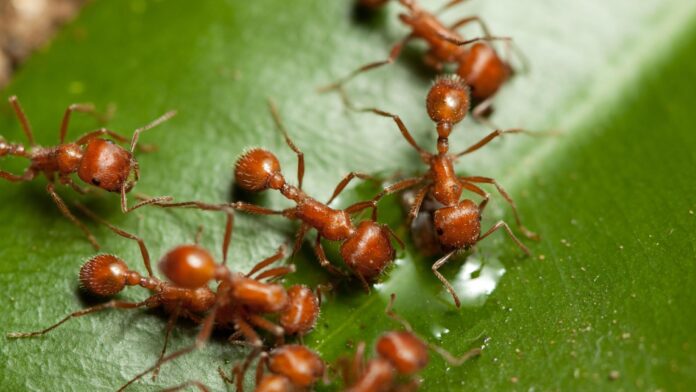Table of Contents
In the realm of home pest management, distinguishing between Red ants and flying ants and termites is crucial for homeowners determined to shield their properties from these invasive species. Both Red ants and flying ants and termites are infamous for their ability to inflict structural harm and exhibit similar swarming behaviors, making it imperative to identify the differences between them for effective pest control. This article provides a thorough examination of Red ants and flying ants, which are frequently confused with termites, and outlines comprehensive strategies for addressing infestations.
Detailed Insights into Red ants and Flying ants
Red ants and flying ants, especially those known as carpenter ants in their winged stage, are characterized by unique physical traits such as elbowed antennae, constricted waists, and wings of varying sizes, with the rear wings smaller than the front. These ants can manifest in several colors, including black, brown, and notably red, signaling their activity in residential areas.
Habitat, Diet, and Behavior
Red ants and flying ants announce their presence by establishing nests in wooden structures, where they excavate tunnels to accommodate their colonies. These ants have a preference for moist, decaying wood but can adapt to drier wood conditions. The sighting of flying red ants or a large-scale infestation underscores the immediate need to rectify any rotting wood issues through repairs or replacement. For nests situated indoors, directly applying insecticides is recommended. When nests are out of reach, employing ant baits, readily available at home improvement stores, serves as an effective countermeasure.
Differentiating Red ants and Flying ants from Termites
Although Red ants and flying ants and termites engage in swarming as a part of their reproductive cycle, certain distinct features aid in their identification:
- Antennae: Red ants and flying ants possess elbowed antennae, unlike the straight antennae found on termites.
- Waist: Red ants and flying ants feature a pronounced waist narrowing, in contrast to the uniform body shape of termites.
- Wings: The wings of Red ants and flying ants are unequal in size, with smaller hind wings, differing from the equal-sized wings of termites.
Termites represent a considerable risk to residential structures due to their consumption of cellulose-based materials, including wood and paper. Distinguishing between the lighter-colored worker termites and the darker reproductive swarmers is essential for timely intervention.
Strategies for Effective Infestation Management
Addressing Red ants and Flying ants
To combat an infestation of Red ants and flying ants, it’s crucial to first eliminate their preferred nesting spots by addressing moisture-related wood deterioration. Subsequently, treating indoor nests with insecticides can mitigate the infestation. In cases where nests are inaccessible, utilizing ant baits emerges as a viable solution.
Tackling Termites
In contrast, termite infestations generally necessitate professional involvement. Given termites’ hidden feeding habits and the extensive damage they can cause, expert pest control services are often required to thoroughly eliminate the colony and prevent additional harm.
Proactive and Preventive Measures
The prevention of Red ants and flying ants and termite infestations starts with upholding the structural integrity of your dwelling. Conducting regular checks for moisture-related damage, sealing potential entry points, and ensuring wood remains dry are fundamental steps. Additionally, eliminating possible food sources and nesting materials from your property’s vicinity can significantly lower the risk of infestation.
Conclusion
Effectively identifying and controlling infestations of Red ants and flying ants and termites demands vigilant observation and immediate action. By recognizing the specific characteristics of these pests and enacting focused control strategies, homeowners can successfully defend their properties against these threats. Routine upkeep, augmented by expert evaluations when needed, establishes the foundation of a holistic pest management approach, safeguarding your home’s safety and comfort.

FAQs
Are flying ants harmful to my home? Flying ants, particularly carpenter ants, can cause damage to wooden structures in your home if they establish nests within damp or rotting wood. Unlike termites, they do not eat the wood but tunnel through it to create their nests, which can weaken the structural integrity over time.
How can I distinguish flying ants from termites? The key differences lie in their physical characteristics: flying ants have elbowed antennae, pinched waists, and wings of unequal size, while termites have straight antennae, uniformly broad bodies, and equal-sized wings. Observing these features closely can help in correctly identifying the pest.
What should I do if I find a flying ant infestation in my home? The first step is to identify and repair any moisture-damaged wood, as this is a common nesting site. Applying insecticides directly to the nest or using ant baits for inaccessible areas can effectively manage the infestation. If the problem persists, consider consulting a professional pest control service.
Can flying ants cause as much damage as termites? While flying ants can cause structural damage by nesting in wood, the extent of damage is generally less severe compared to termites. Termites feed on wood, leading to more significant structural damage over time.
How often should I inspect my home for signs of red ants or flying ants? It’s advisable to conduct regular inspections of your home, especially in areas prone to moisture damage or where wood is in contact with soil. Seasonal checks, particularly in spring and summer when flying ants are more likely to swarm, can help in early detection and prevention of infestations.
Understanding the habits and characteristics of red ants and flying ants is crucial in preventing and managing infestations effectively. By staying informed and proactive, homeowners can protect their properties from potential damage caused by these pests.



